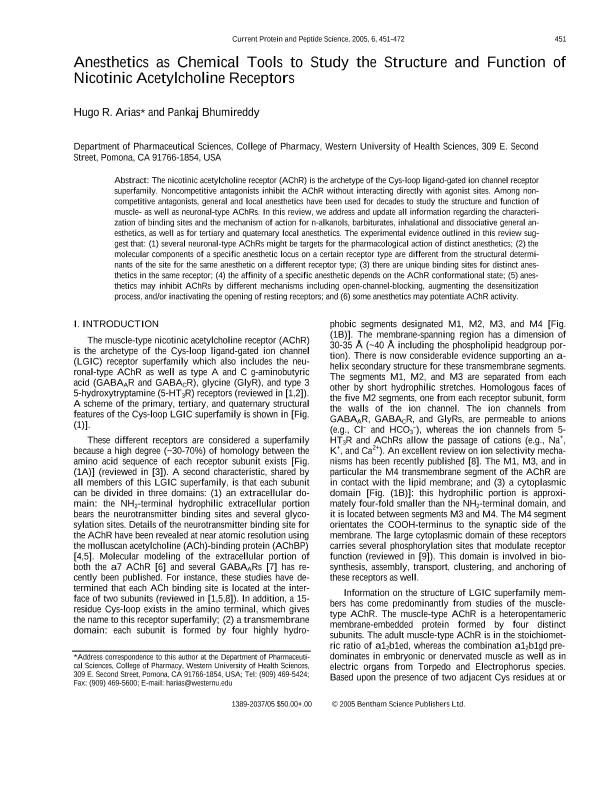Mostrar el registro sencillo del ítem
dc.contributor.author
Arias, Hugo Rubén

dc.contributor.author
Bhumireddy, Pankaj
dc.date.available
2020-02-10T17:48:34Z
dc.date.issued
2005-10
dc.identifier.citation
Arias, Hugo Rubén; Bhumireddy, Pankaj; Anesthetics as chemical tools to study the structure and function of nicotinic acetylcholine receptors; Bentham Science Publishers; Current Protein and Peptide Science; 6; 5; 10-2005; 451-472
dc.identifier.issn
1389-2037
dc.identifier.uri
http://hdl.handle.net/11336/97075
dc.description.abstract
The nicotinic acetylcholine receptor (AChR) is the archetype of the Cys-loop ligand-gated ion channel'receptor superfamily. Noncompetitive antagonists inhibit the AChR without interacting directly with agonist sites. Among non-competitive antagonists, general and local anesthetics have been used for decades to study the structure and function of muscle- as well as neurorial-type AChRs. In this review, we address and update all information regarding the characterization of binding sites and the mechanism of action for n-alkanols, barbiturates, inhalational and dissociative general anesthetics, as well as for tertiary and quaternary local anesthetics. The experimental evidence outlined in this review suggest that: (1) several neuronal-type AChRs might be targets for the pharmacological action of distinct anesthetics; (2) the molecular components of a specific anesthetic locus on a certain receptor type are different from the structural determinants of the site for the same anesthetic on a different receptor type; (3) there are unique binding sites for distinct anesthetics in the same receptor; (4) the affinity of a specific anesthetic depends on the AChR conformational state; (5) anesthetics may inhibit AChRs by different mechanisms including open-channel-blocking, augmenting the desensitization process, and/or inactivating the opening of resting receptors; and (6) some anesthetics may potentiate AChR activity.
dc.format
application/pdf
dc.language.iso
eng
dc.publisher
Bentham Science Publishers

dc.rights
info:eu-repo/semantics/openAccess
dc.rights.uri
https://creativecommons.org/licenses/by-nc-sa/2.5/ar/
dc.subject
MUSCLE-TYPE NICOTINIC ACETYCHOLINE RECEPTOR
dc.subject
LIGAND-GATED ION CHANNEL
dc.subject
TRASMEMBRANE DOMAIN
dc.subject.classification
Bioquímica y Biología Molecular

dc.subject.classification
Ciencias Biológicas

dc.subject.classification
CIENCIAS NATURALES Y EXACTAS

dc.title
Anesthetics as chemical tools to study the structure and function of nicotinic acetylcholine receptors
dc.type
info:eu-repo/semantics/article
dc.type
info:ar-repo/semantics/artículo
dc.type
info:eu-repo/semantics/publishedVersion
dc.date.updated
2019-12-18T13:56:07Z
dc.journal.volume
6
dc.journal.number
5
dc.journal.pagination
451-472
dc.journal.pais
Estados Unidos

dc.journal.ciudad
Oak Park
dc.description.fil
Fil: Arias, Hugo Rubén. Consejo Nacional de Investigaciones Científicas y Técnicas. Centro Científico Tecnológico Conicet - Bahía Blanca. Instituto de Matemática Bahía Blanca. Universidad Nacional del Sur. Departamento de Matemática. Instituto de Matemática Bahía Blanca; Argentina. Western University of Health Sciences; Estados Unidos
dc.description.fil
Fil: Bhumireddy, Pankaj. Western University of Health Sciences; Estados Unidos
dc.journal.title
Current Protein and Peptide Science

dc.relation.alternativeid
info:eu-repo/semantics/altIdentifier/doi/http://dx.doi.org/10.2174/138920305774329331
dc.relation.alternativeid
info:eu-repo/semantics/altIdentifier/url/http://www.eurekaselect.com/79467/article
Archivos asociados
